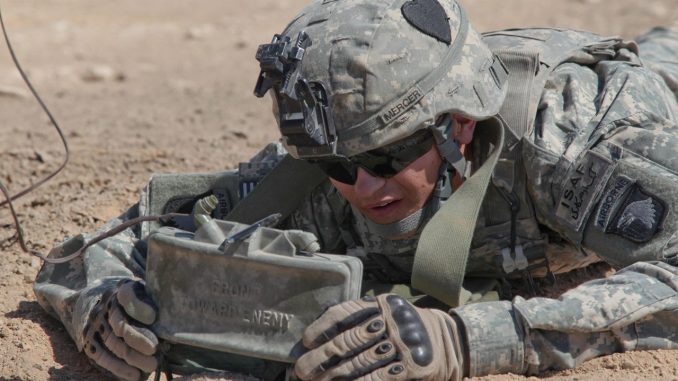
The M18 Claymore anti-personnel mine has been in service with US forces since 1960.
Entry last updated on 10/24/2017; Authored by JR Potts, AUS 173d AB and Dan Alex; Content ©www.MilitaryFactory.com
The M18 was primarily designed by inventor Norman A. MacLeod of the Explosive Research Corporation from a period spanning 1952 to 1956. Developments already being entertained as early as World War 2 to which it was found that an explosion could be “directed”. The Korean War (1950-1953) spurred further thinking into the development of a highly-lethal anti-personnel mine. During the war, UN forces came under constant infantry attacks that included massive concentrations of enemy troops ala the Japanese charges of World War 2. The United States and the Canadian arms industry both took steps to counter these vicious charges by beginning to detail the effects of a directional anti-personnel mine.
The Canadians developed the “Phoenix” which delivered steel cubes against a target area from a 5lb Composition B detonation but was limited in range to just 25 yards. Norman McLeod began developing his version in 1952 into the T-48 concept and was presented to the US Army. The Army liked what is saw and accepted the design (with some modifications) into their inventory as the “M18”. The M18 was evolved into the M18A1 after 1954 to fulfill a Picatinny Arsenal requirement for an improved form. The series as a whole has since been produced by a number of factories around the world in the thousands.
The M18 Claymore anti-personnel mine was developed into two distinct versions – one with a peep-type sight and the other without. The peep sight was devised to help give a Claymore operator a “field-of-vision” for the semi-circle blast pattern presented by the M18 when detonated. A training version is noted by its bold blue color whereas operational M18s have an Olive-color appearance.
The mine component itself consists of a plastic case that is concave and rectangular in shape. Along the “active” side of the case are the embossed words “Front Toward Enemy” while the rear is embossed with “Back” to help keep the operator from making a lethal mistake during setup. The plastic component contains a composition of C3 explosive. The concave nature of the mine’s design allows for a forward blast area that produces a fan-shaped pattern of steel balls across a horizontal arc of approximately 60-degrees. The steel balls packed within the mine are then projected out from just above ground level by the resulting explosion to a height of about 2 meters with a maximum kill radius of 100 meters and an effective kill range of 50 meters. Wounding has been noted as far away as 270 yards from the blast zone though a range of 55 yards is deemed optimal. As can be expected, extreme professional care should be taken during the set up of Claymores. This is not only do to the mine’s inherent explosive nature but the fact that up to 20% of the internal steel ball projectiles can blow back towards a friendly line upon detonation. As such, common practice for M18 setup includes the use of natural earth mounds or hills positioned behind the Claymore to help eliminate or reduce such friendly-fire incidents.
Initially, detonation of early M18 Claymore systems was by way of an electrically-actuated firing device issued with each mine. The firing system was found to not be wholly reliable, sometimes causing premature detonation of the explosive, so a work around was used to replace the M18 battery holder firing device as issued with a standard M57 firing device instead. The M57 device (known as a “clacker”) was held in the hand and featured a trigger that was squeezed a number of times by the Claymore operator to convert mechanical energy into electrical energy using an armature and magnets. The M18 can still be detonated in the electrical or non-electrical fashion which lends herself to be used as a dedicated mine or as an “individual weapon”. In fact, so long as the operator can find a way to actuate the blasting caps, the M18 will trigger.
The M18 Claymore system is roughly 8.5 inches in length, 1.375 inches wide, 3.25 inches high and weighs just 3.5 pounds. 700 steel-based sphere ball bearings (10.5 grains) are used as the projectiles, set within an epoxy resin, and a 1.5lb layer of composition C-4 explosive is used for detonation. Detonation is initiated by a No 2 electric blasting cap. 4 x 6″ spike legs are attached to the bottom of the M18 Claymore system to allow the mine to be easily secured into soft grounds. A bandolier is issued for the carrying of M18 Claymores and also contains an instruction sheet.
As may be surmised, the M18 Claymore is named after the long, large two-handed sword of Scottish descent. The M18 is used by a variety of foreign army forces and some nations have even seen fit to copy the original American design – including the Soviet Union during the Cold War. It falls under a variety of designations in world armies such as the M18 (Chile), Type 66 (China), Viuhkapanos (Finland), IHR-60 (Hungary), VS-DAFM 7 (Italy), P5 Mk 1 (Pakistan), M18A2 (Philippines), MON-50 (Soviet Union/Russia), Shrapnel Mine No 2 (South Africa), K440 and KM18A1 (South Korea), FFV-013, Forsvarsladdning 21 and LI-12 Truppmina 12 (Sweden), MDH-C40 (Vietnam) and MRUD (Yugoslavia).
Arms-Tech Ltd of Arizona makes the MM-1 “Minimore” (“MM-1 Directional Command Detonated Mine / Minimore-1 Miniature Field-Loadable Claymore Mine”) for US Special Forces. It is essentially a scaled-down (1/3 size) and lighter version of the base M18A1 utilized by the US Army. While more limited in its damaging scope, the MM-1 makes up for it in its portability, weighing in at just 14.5 ounces and being 5 inches along its longest facing.
M18 Claymore
Service Year: 1960
Type: Anti-Personnel Mine
National Origin: United States
Manufacturer(s): State Factories – USA
Design (Internal, Dimensions and Weights)
Firing Action: Directional Trigger Sensitive
Available Caliber(s): Not Applicable
Ammunition Count / Feed: Single Use
Overall Length: 216 mm (8.50 inches)
Weight (Empty): 3.50 lb (1.59 kg)
Sighting Assist: Not Applicable
Performance
Typical Range: 164 feet (50 meters; 55 yards)
Global Operators / Customers / Users
Chile; China; Finland; Hungary; Italy; Japan; Malaysia; Pakistan; Philippines; Poland; Russia; Serbia; South Africa; South Korea; Sweden; Turkey; United Kingdom; United States; Vietnam; Yugoslavia
Model Variants (Including Prototypes)
M18 “Claymore” – US Base Series Designation
MM-1 “Minimore” – US Designation; improved portability version developed specifically for US special forces use.
Type 66 – Chinese Designation
Viuhkapanos VP88 / VP84 – Finnish Designation for base series and heavy class mine.
IHR-60 – Hungarian Designation
VS-DAFM 7 – Italian Designation
P5 Mk1 – Pakistani Designation
MON-50 – Russia Designation
Shrapnel Mine No 2 – South African Designation
K440, KM18A1 – South Korean Designations
FFV-103, Forsvarsladdning 21, LI-12, Truppmina 12 – Swedish Designations.
MDH-C40 – Vietnamese Designation
MRUD – Yugoslavian Designation
| [adrotate group=”4″] |
[adrotate banner=”24″]

[pt_view id=”517b65fj16″]












Be the first to comment